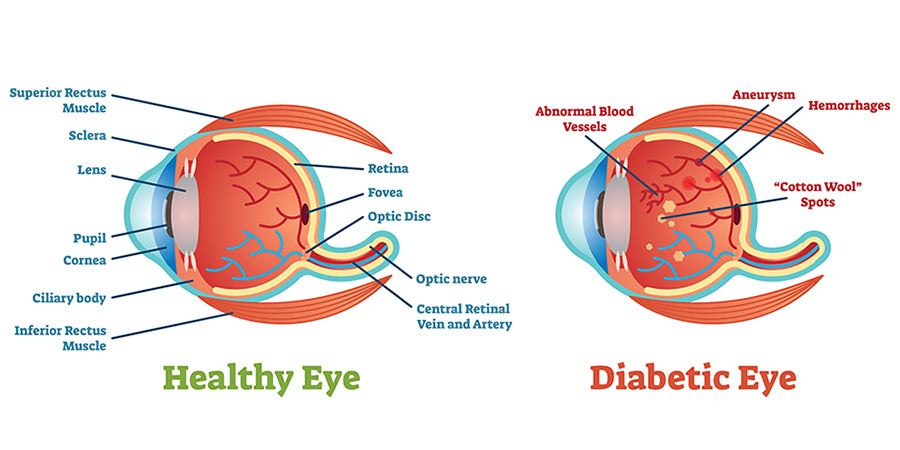Website to merge into Ochsner.org on August 8!
ochsner.org
ochsner.org
Diabetes affects the blood vessels in the entire body. The vessels in the eyes are amongst the smallest in the body, which means they often are the first affected. These leaky vessels can cause a number of problems in the eyes, including bleeding, swelling, fatty deposits and loss of blood supply to the retina. These problems can cause new blood vessel growth, scarring and even retinal detachments. Diabetes can wreak havoc on the eyes and ultimately can cause severe loss of vision. Often, we don’t have any symptoms of this until it is too late to reverse, and sometimes, even treat. This is why annual eye exams are essential in diabetic patients. We must diagnose the condition early, and then follow its advancement closely, so patients do not ultimately lose their vision irreversibly.

As blood sugar levels rise, a common cause of diabetes, your blood vessels can become damaged throughout your body. This includes the tiny blood vessels that go into your retina, the membrane that covers the back of your eyes, detects light and sends signals to your brain through your optic nerve.
If sugar damages the retina enough to block oxygen from reaching those vessels, which are incredibly small, it can cause them to leak or even bleed. To compensate, your eye may grow new blood vessels in an effort to better receive blood, but those vessels are typically weaker and bleed more easily than your originals. As your blood sugar levels rise and these weaker vessels fail, your eye accumulates excess fluid and the shape and curve of your eye lens (which controls vision) can change drastically, causing extreme changes in vision and even complete vision loss without proper treatment.
Complications can include bleeding in the vitreous (the “jelly” that fills your eye), which can block light either partially or completely, a detached retina or and even glaucoma, which is a blockage of fluid in the eye that can increase the risk of long-term optic nerve damage and vision loss.
In the early stage, known as non-proliferative diabetic retinopathy (NPDR), the disease typically doesn’t produce any symptoms, and, unless macular swelling has occurred, only really becomes noticeable as it advances into proliferative diabetic retinopathy (PDR).
PDR symptoms may include:
More people than you may think. According to a recent CDC study, diabetic retinopathy is the leading cause of blindness in diabetic adults over the age of 40. And, according to the National Eye Institute, more than 2 in 5 Americans with diabetes have some stage of diabetic retinopathy.
Anyone with diabetes is at risk of developing diabetic retinopathy, but the risk is higher if you:
As stated above, the disease generally starts without any noticeable changes in your vision. If you have a history of diabetes or have recently been diagnosed, it’s incredibly important to talk with your primary care provider about regular eye exams. This allows them to diagnose you early, so you can get appropriate treatment to prevent any visual loss. Ophthalmologists are eye specialists that are trained to detect any early signs through a number of different exams.
Successfully managing your blood sugar levels and blood pressure can also help prevent the disease, so it’s important that, once you’re diagnosed with diabetes or hypertension, you work closely with your doctor to control those levels as much as possible, that includes:
By catching the disease as early as possible and managing your diabetes, your likelihood for prevention and, if you do develop diabetic retinopathy, successful treatment—as well as keeping your eyes healthy and vision intact—increases drastically.
Depending on the severity of the condition and how it responds to other treatments, there are several methods your doctor may utilize to treat diabetic retinopathy.
In some cases of advanced diabetic retinopathy, surgery may be required and can range from laser treatments to injections to a surgical vitrectomy, which is a procedure that removes some of the vitreous from your eye.
May is Healthy Vision Month, a month dedicated to raising awareness to the importance of keeping your eyes healthy – and that it should be as big of a priority as eating heathy and staying active. Make it your month to schedule a comprehensive eye exam with one of our experienced Ophthalmologists today!